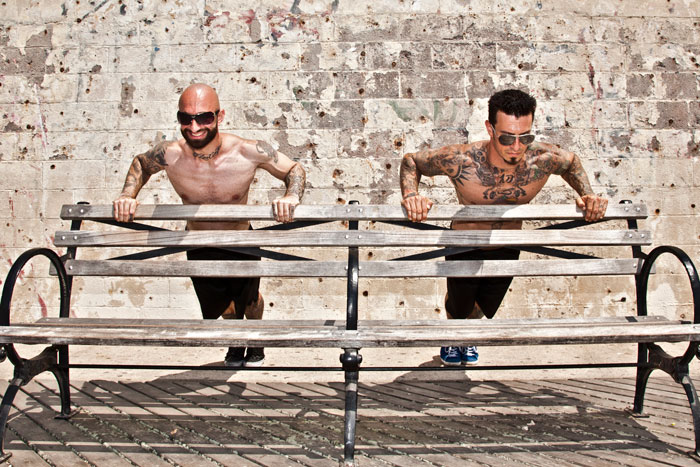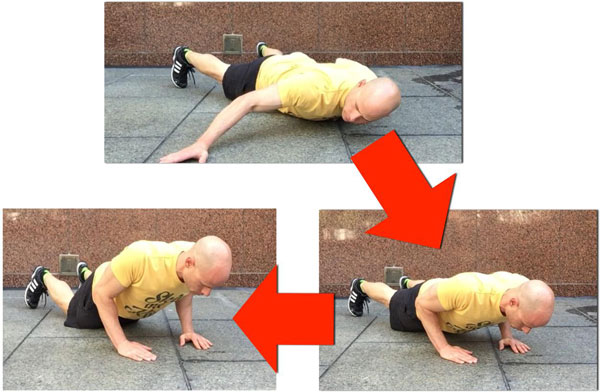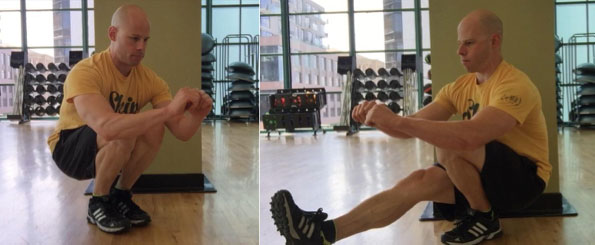
I once attended a very high level Taekwon-Do seminar taught by an Olympian ranked 3rd in the world. I was looking forward to learning a lot of advanced techniques–yet here we were, all of us black belts, simply learning how to stand still.
The instructor spent the rest of the day drilling us on how to improve the techniques we all learned years ago. Even though we never strayed beyond the “easy” kicks and punches, we all became much better by the end of the weekend. Since that seminar, I’ve taken that lesson to heart not only with Taekwon-Do but also calisthenics.

When I first discovered Convict Conditioning, I made the mistake of rushing into the more advanced steps. This was despite ample instruction not to do that in chapter 11! Even though I could (barely) meet a regression standard, I figured I had passed that level and no longer had any need for that technique. After all, I could do loads of close push-ups, so why would I ever need to practice push-ups on my knees?
But, just like my Taekwon-Do, I’ve learned that I’m never above the earlier steps. There are always a few nuggets to discover with the earlier steps no matter how many reps I can do of the more advanced techniques. Here are a few examples of how the earlier steps can still hold some value to your training.
1: Warming Up
It would be considered foolish to load a bar with your maximum working weight for your first set, yet that’s exactly what I used to do. I would go from 0-100 mph as I cranked out reps of the the hardest step I could muster. Is there any wonder why I was plagued with muscle control issues, balance issues, and sore joints after a few weeks?
These days I always start my workouts with some of the first level steps of each exercise. If I’m practicing bridges I still start with step 1 (short bridges) to wake up my posterior chain and loosen up my hips. As a bonus, this approach to my practice also allows me to fully dial in my mind-muscle connection. My body and mind will both be warmed up for the next steps. It also helps me get a feel for the state of my body, so I know if I can push hard or if I should take it easy that day.
2: Muscle Building High Fatigue Drop Sets
In Paul Wade’s article, “the Diesel 20”, he mentions using easier techniques to highly fatigue a muscle group towards the end of a workout.
On of my favorite methods is to start with archer push-ups, then drop down to the narrow push-ups, then normal push-ups, and finally push-ups on the knees.

3: Filling in Tension Gaps
For the longest time I’ve always noticed my back and biceps muscles would fully contract at the top of a pull-up but they tend to relax a bit towards the bottom of each rep.

I refer to these points as tension “gaps”. These gaps can be detrimental to muscle development, strength, power and can place more stress on the joints.
One of the best ways to fill in these gaps is to use an easier technique and practice proactively tensing the muscles at these weaker points in the range of motion. By going to the Jackknife pull-up, I was able to work on maintaining the tension in my back while keeping my shoulders and arms tight at the bottom of each rep. This is much easier on the earlier steps because my muscles are not overridden by a much higher level of resistance.
4: Learn What’s Missing
Many times I’ve struggled to advance because I was missing a critical technical detail.
The worst example was my journey into single leg squats. Again, I was foolish and just breezed through some of the earlier steps thinking I was above them. Within a couple of months, I was doing 10 single leg squats on each leg. The catch was I was tilting and moving all over the place and sometimes had to slightly bounce out of the squat. I also had to do them on an elevated surface so my front leg could extend below the level of my supporting foot.
After a year, I developed tendonitis in my right knee and it got so bad I had trouble walking up stairs. I struggled to figure out what was wrong for months, and was sometimes on the verge of tears with frustration. As a mountain athlete I need strong and healthy legs to hike, ski and pedal and here I was hobbling around like an old man.
I finally swallowed my pride and started all the way back at step 1 in the squat progressions. By the time I had made it to narrow squats, I had learned that my legs had exceptionally unbalanced development in the hips and hamstrings.

It’s been over a year now and I’m back to doing single leg squats. Now there is no bounce, no tipping or wobble and I don’t need an elevated surface. Even though my numbers are far lower than before, my legs have never been stronger or healthier. I would never have figured out where my technique shortcomings were unless I went back and explored the earlier steps to a deeper level.
5: Learning to Use the Body Better
I believe Progressive Calisthenics is more than just a system for building strength and muscle. To me it’s a vehicle towards understanding my own body and learning how to use it better. Using the earlier steps has always been exceedingly helpful towards doing this. I can always control myself and dial in cleaner technique with an earlier step than I can with an advanced step. My mission is to learn why the earlier steps are so much cleaner and more stable. Once I know why, I work on bringing those qualities up to the more advanced moves. Of course, as my advanced moves become better so do my earlier steps and the whole process starts over again. In this way the quality of the earlier techniques feeds into the more advanced moves and the advanced moves make it possible to learn even more from the earlier moves. It’s a cycle that’s infinitely progressive.
In the martial arts, the student is always encouraged to retain the lessons they learned at the previous ranks. There’s a reason why students are encouraged to have a “white belt mindset.” The color black is made up of all of the rank colors that come before it so when you wear a black belt you’re still wearing a white belt, a green belt and so on. The earlier belts, and the exercises they represent are never discarded. They simply remain in the mix. The same thing is true for calisthenics, the earliest steps are never discarded but are recycled and re-purposed.
Discard nothing and gain everything!
****
Matt Schifferle a.k.a. The Fit Rebel made a switch to calisthenics training 5 years ago in an effort to rehab his weight lifting injuries. Since then he’s been on a personal quest to discover and teach the immense benefits of advanced body weight training. You can find some of his unique bodyweight training methods at RedDeltaProject.com and on his YouTube channel: RedDeltaProject.
